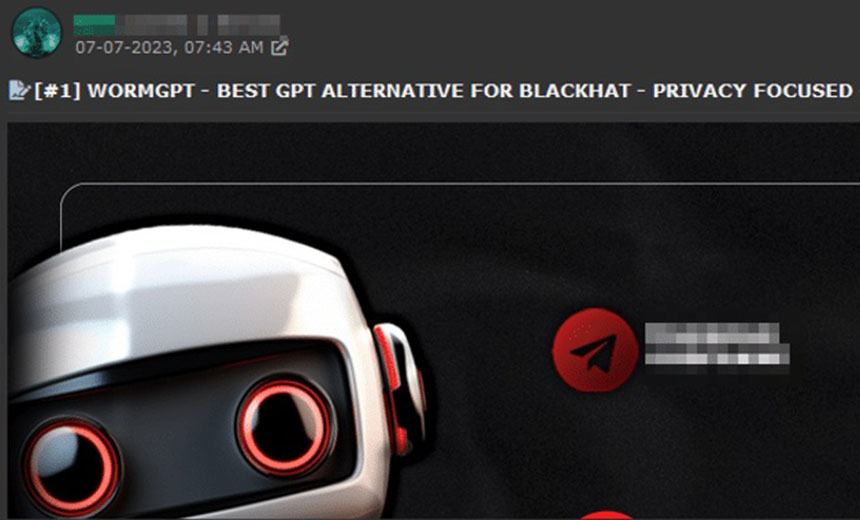Inside the Rise of 'Dark' AI Tools - Scary, But Effective?

This shouldn't be surprising, since building LLMs is an intensive endeavor. "As
what WormGPT showed, even with a dedicated team of people, it would take months
to develop just one customized language model," Sancho and Ciancaglini said in
the report. Once a product launched, service providers would need to fund not
just ongoing refinements but also the cloud computing power required to support
users' queries. Another challenge for would-be malicious chatbot developers is
that widely available legitimate tools can already be put to illicit use.
Underground forums abound with posts from users detailing fresh "jailbreaks" for
the likes of ChatGPT, designed to evade providers' restrictions, which are
designed to prevent the tool from responding to queries about unethical or
illegal topics. In his WormGPT signoff earlier this month, Last made the same
point, noting that his service was "nothing more than an unrestricted ChatGPT,"
and that "anyone on the internet can employ a well-known jailbreak technique and
achieve the same, if not better, results by using jailbroken versions of
ChatGPT."
4 ways simulation training alleviates team burnout
Simulation training boosts confidence because unlike traditional training
methods, the learner gains experience over time through true-to-life virtual
cyber warfare training and sparring against simulated malicious adversaries
that behave like human opponents. By training in the same IT infrastructure
they have at their job— complete with networks, servers, and security
tools—they improve competencies, judgment skills, and gain “muscle memory” so
they feel prepared to respond to a real cyber incident. ... With simulation
training, SOC teams learn to identify false positives and high-priority alerts
more effectively over time as they become familiar with the types of alerts
that end up impacting their organization’s infrastructure. The training can
mimic the high volume of alerts they receive during the day and help teams
develop effective triage strategies to streamline their response processes.
Practicing this in simulation allows teams to experiment on their approach and
fine-tune it without fear of making a mistake during operating hours.
A managerial mantra in the age of artificial intelligence

The rise of modern management brought forth professionalism through business
schools, advocating ethical standards and fostering professional workplaces
globally. Often, this professionalism is rooted in the mastery of managerial
principles. These principles are created and taught by a variety of business
school professors, and they are developed in close collaboration with
executives and leaders. Unfortunately, a lot of these ideas have only been
applied sparingly due to practical limitations. These limitations may result
from the limited time available for decision-making in the corporate world,
the need to manage uncertainties, the lack of data and accurate knowledge of
the facts, and occasionally even the ignorance of professional principles. ...
Organisational thinkers have traditionally identified that this leads to
satisfaction, whereby managers have to be satisfied with the good-enough, not
necessarily the best, choice. In other words, constraints on time availability
lead a manager to do a limited analysis of the impact of a job candidate on
future organisational performance.
Five Challenges in Implementing AI in Automation

Accuracy and bias are two critical, yet recurring issues in AI that require
human supervision. For example, generative AI applications are prone to
hallucination, or making up facts based on their training dataset. In the
same vein, biased datasets fed into a machine learning model can produce
biased results. If a financial services firm is using an AI-driven automated
system to accept or reject credit applications, for example, it’s essential
to avoid well-documented, systemic biases toward women or people of color
that may be contained in the training dataset. As we progress toward
AI-driven decision-making, it’s critical for humans to remain in the loop,
verifying the results generated by machine learning algorithms to check bias
and other forms of inaccuracy. Keeping humans in the loop is a critical step
toward re-training algorithms to perform more effectively in a production
environment. ... Regulating AI is an ongoing issue globally, and the legal
field continues to be shaped by emerging technologies including generative
AI.
Mastering Agile Security: Safeguarding Your Projects in a Fast-Paced World
Just ensuring rapid delivery of the product is not enough. The key to Agile
success is to ensure that security is an integral part of the process from
the beginning. And since agile is an iterative process, and is all about
accommodating changing requirements as and when they arise, security must
also be part of this iterative process. Regular security reviews and tests
whenever there is a change in the product is the key to delivering a working
as well as secure product. ... Agile security is not an impediment to the
Agile process; rather, it's an essential component that ensures the final
product is robust, resilient, and safeguarded against potential threats.
It's not about slowing down development but about integrating security
seamlessly into every phase of the project lifecycle. ... At the core of
Agile security is the Agile mindset. This mindset emphasizes collaboration,
adaptability, and constant improvement. Security is not a one-time event but
an ongoing effort that requires the entire team's commitment.
Managing Software Development Team Dynamics from Within

In most cases, the whole team will benefit from trying new tools or services
every now and then, just to understand patterns and trends. We know we
should always be increasing automation. However, especially with things like
JavaScript frameworks, up jumps the New Pusher — too keen to adopt the new
when no evidence exists that the gains are worth the disruption cost. Or
worse, ignoring the disruption cost entirely. The New Pusher can make the
team pine for the road not taken, as opposed to do what they should do, and
investigate a little on their own time to see how the team will truly
benefit from their shiny find. When thinking about adopting a new tool or
service the team should not trial it somewhere inconsequential, as that will
be neither conclusive nor beneficial. A short examination or study period
should lead to a yes/no decision and the use of the tool or platform
somewhere of value. Once the pattern is set, the New Pusher can work to that
template. The suspicion that people just want to put new experiences on
their CV is a little irrelevant.
How Generative AI Is Making Data Catalogs Smarter

Sequeda explained how generative AI, which leverages conversational,
chat-oriented interfaces to surface results from large language models
(LLMs), improves productivity and encourages the adoption of a data catalog.
With more traditional data catalogs, administrative tasks require more
significant manual interventions, time, and some advanced skills and
analysis. Smart catalogs remove these barriers by simplifying and automating
some of the administrative workflows. As a result, team members in an
organization see faster time to value and find it easier to get started with
the catalogs. On the data producers’ end, Sequeda said, “Generative AI
automatically enriches metadata around the inputs and provides descriptions
and synonyms” in the data catalog, smoothing catalog record creation and
upkeep. Also, smart data catalogs give data engineers “code summaries” about
catalog queries, reducing the time to do DataOps, including any pipeline
malfunctions. Using smart data catalogs, consumers find inspiration when the
generative AI suggests alternative queries from previous searches and
patterns of results.
Four Myths About Digital Transformation And How To Debunk Them By Modernizing At The Data Layer

A data fabric architecture is essentially a data mesh with an added
“abstraction layer” that virtualizes all data into a centralized platform.
The benefit is a single pane of glass for all data, virtualized and
contextualized for a broader range of business users to work with. The
trade-off is that this sudden visibility can be daunting for DX teams newly
tasked with untangling all the previously unseen dependencies,
vulnerabilities, governance issues, and compliance or security gaps that
suddenly appear. All three approaches remain represented in today’s
marketplace for organizations to choose from. And while the calculus for
making the choice will vary for each company based on their DX goals and
level of technical expertise, a common ingredient to success is to
prioritize scalable and repeatable processes through automation and low-code
wherever possible. ... Choosing the right underlying data architecture is an
ongoing balance of matching the pros and cons of the approach to the
specific business and operational needs of the organizations.
A license to trust: Can you rely on 'open source' companies?
Amanda Brock, OpenUK's CEO, which doesn't have a horse in the IaaS race,
appeared disappointed with the company's move. "HashiCorp has always been a
true open source company, and what Mitchell Hashimoto and Armon Dadgar
achieved from a project never intended to be commercialized has been
incredible." Brock then asks, "Taking it to an IPO and seeing Mitchell have
the apparent wisdom to step aside and allow a more experienced individual to
run HashiCorp – but has that also led to its downfall as an open source
company?" Her answer is yes. "The statements about BSL are sadly
open-washing. It would be wrong to suggest these two ever intended a bait
and switch, but they have indeed switched away from open source. The
pressure of enabling their competitors with their innovations – an
inevitability of open source – did not align with the need to generate
shareholder value." That led her to another, bigger question: How much money
is enough? Is a lot of money with others generating a lot of money, too, a
reason to stop?" She's left "wondering whether had Mitchell remained CEO,
this would have occurred?"
Culture Transformation: What leaders need to know

Fortunately, culture only appears enigmatic: There are practical, tangible,
measurable ways leaders can properly manage their culture. And it all starts
with alignment. Executives need to be on the same page with their leadership
teams -- particularly CHROs -- about where their culture stands today and
where it’s headed in the future. You might be thinking: “We’re already
aligned about our culture.” But it’s not enough to be generally on the same
page. The best leaders are synchronised on specific, seemingly small details
about their culture and how they affect performance. In one of our client
organisations, the goal of being a high-performance culture is behind all
decisions. Every leadership meeting keeps high-performance front and centre
in their conversation. For instance, leaders might be on the same page about
the core values and beliefs -- such as customer-centricity or excellence in
safety outcomes -- that they want their culture to embody. But the best path
to excellence varies tremendously by industry, market segment, product and
more.
Quote for the day:
"Success is not a random act. It
arises out of a predictable and powerful set of circumstances and
opportunities." -- Malcolm Gladwell
No comments:
Post a Comment